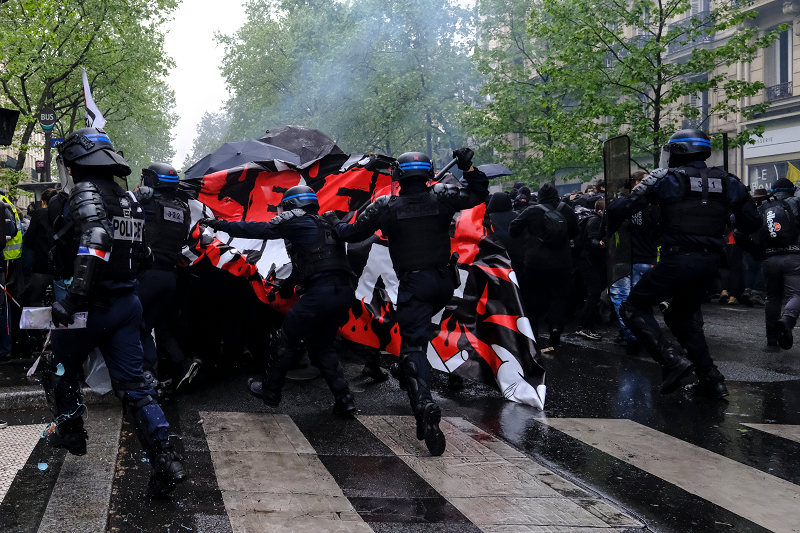From the first protests against pension reform in January 2023 up till 1 May, 2023, the relationship between the French forces of law and order and protesters has been characterised by frequent reports of strong-arm responses and confrontations. This was also seen during the 2010s, particularly during the ‘gilets jaunes’ movement.
The maintenance of public order has in effect been characterised in the last few years by a certain brutality and a tougher attitude.
That a shift has occurred is evident from the work of varied specialists, who have based their research on interviews conducted with police officers, gendarmes, or members of the prefectural institutions; on internal documents and the archives of security forces; and on international perspectives.
Thus, the negotiated management of social conflicts that is based on bargaining with unions and a certain tolerance for trouble caused by protesters, has been replaced by a far harsher model of maintaining public order. The aim of this seems to be preventing protests, rather than facilitating their smooth running.
The maintenance of public order has in effect been characterised in the last few years by a certain brutality and a tougher attitude, including an increased use of penal and administrational tools against protesters.
A failing change in doctrine
Yet, when the protests against pension reform began in January, any difficulty regarding the policing of protest seemed to be ancient history. Since the replacement of Didier Lallement by Laurent Nuñez as Paris’ police commissioner, there has been a preference for a different approach to managing protests in Paris.
Police and gendarmes no longer flank protesters at close quarters but now place themselves at a distance in adjacent streets.
Police and gendarmes no longer flank protesters at close quarters but now place themselves at a distance in adjacent streets. And unions and their security forces oversee the organisation of protests, in concert with officials and forces of law and order.
But this narrative of a “softening” does not stand up to analysis, masking police excess when faced with protesters. A freelance journalist was injured thus and had a testicle removed after being struck with a baton by a policeman during a protest on 19 January in Paris. Moreover, the apparent change in strategy after the appointment of Laurent Nuñez did not stop the unjustified beatings of a few dozen people protesting peacefully during police charges (19 January, 31 January, and 11 February).
In particular, from 16 March on, and after the government forced through its pension reform without a vote by using Article 49.3 of the Constitution, journalists and observers have documented widely how police forces have used physical violence against protesters. They have employed arbitrary arrest, and tactics of humiliation during the night-time marches (which unions didn’t declare) after the recourse to Article 49.3.
Interrogative police squads and legal mechanisms
Criticisms have mostly focused on the activity of BRAV-M, a police unit created in 2019 to crack down on the unpredictable and unruly marches of the ‘gilets jaunes’ . Videos circulating on social media showed members of BRAV-M driving over a protester on the ground with a motorbike, knocking protesters out with a blow to their back, or clubbing protesters or people crossing their path at random.
This backs up the idea that the aim of custody is not so much to put a suspect in front of a officer of the judicial police (OPJ) but simply either to punish an individual for participating in a protest or to “empty the streets”.
But other images attest just as much to violences committed by members of units specialised in riots and crowd control, like the Compagnies républicaines de sécurité (CRS) or the Compagnie d’Intervention (CI).
In total, since the start of the protests, the oversight body of the national police force (IGPN) has had 53 legal investigations, mostly regarding the protest on 1 May, whilst the country’s human rights watchdog (ie, in French défenseur des droits) has had 115 investigations (figures date from 17 April) regarding alleged police violence.
Arrests, if they can be described thus, are often arbitrary as few result, at the end of the process, in a charge. And so, the evening of 16 March, although 292 people were placed in custody, the police only charged nine people, handing out very mild penalties.
The following day, 64 people were placed in custody and six of them were charged. This backs up the idea that the aim of custody is not so much to put a suspect in front of a officer of the judicial police (OPJ) but simply either to punish an individual for participating in a protest or to “empty the streets”.
A gradual crackdown
How can we explain this shift towards repression since mid-May? The security forces, backed by the government and police unions, explain it three ways. These arguments were already current during the ‘gilets jaunes’ protests in December 2018.
The first explanation relates to the riot-like quality of the most recent protests. Routine methods of controlling protests organised by several unions are deemed insufficient for maintaining order. The second explanation points to the fact police are exhausted and weary due to the frequency of these protests and overworked forces are liable to overreactions and blunders.
The third explanation relates to the violence which police forces are subjected to, as numerous images have shown, like this policeman who collapsed after a blow to the head during the protest in Paris on 23 March. Figures released by the Ministry of the Interior revealed 441 police officers were injured during only one day in Paris.
Un policier s’effondre après avoir reçu un projectile sur la tête.#NonALaReformeDesRetraites #greve22mars #manif23mars #CensurePopulaire #GreveGenerale #ReformeDesRetraites pic.twitter.com/yPEzP74qJG
— La Luciole – Média (@laluciolemedia) March 23, 2023
Violence employed by police forces are therefore presented as a state response to this surge. These explanations cannot be brushed aside given the transforming repertory of protestors, and the violence of certain minority actors. This is facilitated in Paris by the urban environment, notably the piles of rubbish in the streets.
A lack of interest in de-escalation techniques
There is a persistent lack of interest from the different authorities (interior ministry, Paris’s prefecture of police, the national police and the national gendarmerie) in the concept of de-escalation.
There is a persistent lack of interest from the different authorities (interior ministry, Paris’s prefecture of police, the national police and the national gendarmerie) in the concept of de-escalation.
This approach aims to delay or even avoid resorting to force, by prioritising other strategies (delays, dialogue, withdrawal of police forces) as much as possible. To ignore these strategies, drives security forces to adopt brutal tactics as soon as there is any sign of difficulty. This marks France apart from a great number of European countries.
Aside harming the reputation of France internationally, backing a confrontational strategy has two major adverse effects.
First there are human consequences for individual victims which range from attacks on their freedom to protest to serious physical harm. Then it also tends to heighten hostility on the part of protesters, even those who were peaceful at the start.
This type of strategy leads to more antagonism generally between protesters and security forces, human rights advocates, and professional bodies charged with protecting police officers. Here lies the risk of the ‘hard power trap’: worsening relations mean that compliance is only reached through constraint, as international research on police work has shown for many years.
What the history of police work teaches us
The history of the police shows that certain periods are more favourable to a collective examination of the conditions that grant police legitimacy. In France, between the 1970s and 1990s, a package of practices was developed based on three principles (“foresight, negotiation, control”). This was an outlook based on a growing acceptance that conflict could be calmed through protest movements. Security forces specialised in maintaining order (mobile gendarmerie squads, and the CRS) have interiorised these less aggressive practices that are based on collective method of oversight.
In a recent work, we argued that France’s model of policing that once drew its legitimacy from preserving the political order, must henceforth adapt to the need to ensure peace and strengthen the authority of its agents in the eyes of a more varied and unequal French society.
This question becomes more important in the context of maintaining public order. At a time when the functioning of representative democracy is being structurally called into question, and where new forms of protest will surely emerge, it seems essential to take the time to rethink how order is maintained, by balancing the legitimate and proportional use of force with the respect of individual liberties.
This article is republished from The Conversation under a Creative Commons Licence. Read the original article.
About the authors
 Jacques de Maillard is Professor of Political Science at the University of Versailles-Saint-Quentin in Yvelines and at Sciences Po Saint Germain in Laye, and Director of the Center for Sociological Research on Law and Penal Institutions. He specialises in policing and public safety issues. In addition to numerous scientific articles, he has published (with Fabien Jobard) Sociologie de la police. Politics, organisations, reforms (Paris, Armand Colin, 2015), and Police and society in France (co-dir. with Wesley Skogan) (Paris, Presses de Sciences Po, 2023).
Jacques de Maillard is Professor of Political Science at the University of Versailles-Saint-Quentin in Yvelines and at Sciences Po Saint Germain in Laye, and Director of the Center for Sociological Research on Law and Penal Institutions. He specialises in policing and public safety issues. In addition to numerous scientific articles, he has published (with Fabien Jobard) Sociologie de la police. Politics, organisations, reforms (Paris, Armand Colin, 2015), and Police and society in France (co-dir. with Wesley Skogan) (Paris, Presses de Sciences Po, 2023).
 Aurélien Restelli is a Doctor of Sociology at CESDIP, University of Versailles-Saint-Quentin in Yvelines. A former student of ENS Cachan, holder of a Master 2 in sociology from EHESS and author of a research paper on Citizen Voluntary Service (under the supervision of Cédric Moreau de Bellaing), Aurélien Restelli is preparing a thesis entitled ‘Cooperating in maintaining order: the police put to the test of pluralization’, under the direction of Jacques de Maillard.
Aurélien Restelli is a Doctor of Sociology at CESDIP, University of Versailles-Saint-Quentin in Yvelines. A former student of ENS Cachan, holder of a Master 2 in sociology from EHESS and author of a research paper on Citizen Voluntary Service (under the supervision of Cédric Moreau de Bellaing), Aurélien Restelli is preparing a thesis entitled ‘Cooperating in maintaining order: the police put to the test of pluralization’, under the direction of Jacques de Maillard.
Picture © Alexandros Michailidis / Shutterstock


